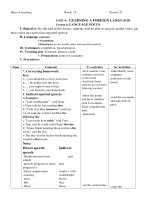- Trang chủ >>
- Cao đẳng - Đại học >>
- Luật
Anh 6 ( mới) Unit 4 - Lesson 1
Bạn đang xem bản rút gọn của tài liệu. Xem và tải ngay bản đầy đủ của tài liệu tại đây (105.17 KB, 4 trang )
<span class='text_page_counter'>(1)</span><div class='page_container' data-page=1>
<b>UNIT 4: MY NEIGHBOURHOOD</b>
<b>I. Objectives.</b>
- By the end of the unit, students will be able to:
<b>+ pronounce correctly the sounds / I / and / i: / in isolation and in context.</b>
+ use lexical items related to the topic “My neighbourhood”.
+ use adjectives to compare things.
+ read for specific information about good things and bad things in the neighbourhood.
+ talk about different places and show directions to these in a neighbourhood.
+ listen for specific information about directions to some places in a neighbourhood.
+ write about what they like and dislike about their neighbourhood.
- Students will be developed 4 skills: speaking , listening , reading and writing.
- Students will be educated to love their neighbourhood more and they will like learning
English more and more.
<b>II.Teaching aids. </b>
- Textbook, lesson plans, board, chalks, cues, posters, real objects, pictures, computer and
the CD record.
<b>III. Procedure.</b>
Lesson 1: Getting started
Lesson 2: A closer look 1
Lesson 3: A closer look 2
Lesson 4: Communication
Lesson 5: Skills 1
Lesson 6: Skills 2
Lesson 7: Looking back + Project
<b>---Date of preparing: Period: 26 </b>
<b>UNIT 4: MY NEIGHBOURHOOD</b>
<b>LESSON 1 : GETTING STARTED ( P. 38 - 39 )</b>
<b>A.OBJECTIVES: </b>
<i><b>1. Knowledge By the end of this lesson, students will be able to listen and read the dialogue</b></i>
among Phong, Nick, Khang and a girl to understand the details then do some more tasks;
talk about different places and show directions to some places in a neighbourhood.
+ Vocabulary: historic, cathedral, memorial, palace, art gallery, hurry
+ Grammar : Use “shall” to make suggestions.
<i><b>2.Skills : Practice and develop lisening and reading and speaking skills .</b></i>
<i><b>3.Attitude: Political thought and moral sence: Educate students to love their neighbourhood </b></i>
more and they will be interested in learning English more.
<i><b>4. Competence: Ss can talk about different places .</b></i>
<b> B.TEACHING AIDS: .</b>
- Textbook , teacher’s book , lesson plan , board , chalks, pictures, posters, stereo and the
CD record.
</div>
<span class='text_page_counter'>(2)</span><div class='page_container' data-page=2>
<i><b>I.Oganization: (1minute)</b></i>
<b>Class</b> <b>Date of teaching</b> <b>Absent students</b>
<b>6C</b>
<i><b>II. Revision / Warmer: (5 minutes)</b></i>
<i><b>* Matching- T hangs the poster on the board.</b></i>
<b>A</b> <b>B</b>
1) temple
2) rainway station
3) square
4) statue
5) get lost
a) bị lạc
b) tượng
c) ga xe lửa
d) đền
e) quảng trường
- T runs through the poster.
- T gives the instructions: You match one English word in column A with its meaning in
column B.
- T models one. 1 - d
- T checks ss' understanding.
- T calls one by one student comes to the board to match.
- T corrects and praises ss.
<i><b>+ Answer key: 1- d; 2- c; 3 - e; 4- b; 5 - a.</b></i>
<i><b>III. New lesson: (37 minutes)</b></i>
<i><b>Step1: Presentation. (15 minutes)</b></i>
<i><b>* Vocabulary:</b></i>
- historic (adj): cổ, cổ kính (explanation)
- hurry (adj): vội vàng ( antonym) - thong thả
- cathedral (n): nhà thờ lớn, thánh đường ( picture)
- memorial (n): đài tưởng niệm ( picture)
- palace (n): cung điện (picture)
- art gallery (n): phòng trưng bày nghệ thuật (example)
<i><b> + Concept check: What and where .</b></i>
<i><b>* Presentation dialogue:</b></i>
+ Set the scene:
- T shows the picture in the textbook P. 38 then asks Ss some questions.
T: Where are Nick, Khang and Phong? - In Hue
What might be happening to them ? - get lost
Have you ever got lost? - Ss’ answers
Where and when?
How did you feel?
What did you do?
- T says: You’ll listen and read the dialogue among them.
- T gives the instructions: You look at the dialogue then listen to the tape.
- T turns on the tape twice.
- Ss listen and read.
- T calls four good students to read again the dialogues.
- T asks the others to correct.
<i><b>- T corrects Ss' mistakes. </b></i>
<i><b>* Ordering ( Part 1. a P. 39)</b></i>
- T hangs the poster with 6 statements in part 1. a P. 39 on the board.
- T runs through the poster.
</div>
<span class='text_page_counter'>(3)</span><div class='page_container' data-page=3>
2 is the first.
- Ss do individually then they compare with their partners.
- One by one student comes to the board and writes one answer.
- T controls then corrects,
<i><b>+ Answer key : 2 - > 5 -> 3 -> 4 -> 1 -> 6</b></i>
<i><b>* Ordering ( Part 1. b p. 39 )</b></i>
- T shows the poster with the contents of part 1. b on the board then runs through.
- T gives the instructions: Read again the dialogue then put the words in the correct order.
- T models the first one.
1. Where shall we go first?
Let’s go to Chua Cau.
- T checks Ss’ understanding.
- Ss work in pairs.
- T gets Ss’ answers and write on the board.
2. Shall we go there first?
OK, sure.
3. Shall we go by bicycle?
No, let’s walk there.
- T models the above sentences.
- Ss cochus - open pairs.
- T checks forms meaning, use and the pronunciation.
Shall + S + Vinf + Obj? -> make suggestions.
<i><b>Step2: Practice: (12 minutes)</b></i>
<i><b>*Activity 1: Role - play( part 2 p. 39)</b></i>
- T asks Ss to look at the onversation in the textbook p. 39 in part 2.
- T models - Ss chorus -> Pairs.
- T models the role - play with a more able student.
- T asks Ss to work in pairs to role - play the same conversations.
- T asks two pairs to demonstrate for the class.
- T asks Ss to give the comments -> T corrects.
<i><b>* Activity 2: Matching ( Part 3 p. 39)</b></i>
- T asks Ss to look at all the places in the box then runs through.
- T also runs through the 8 pictures.
- T gives the instructions: Match the places with the pictures.
- T models one.
Picture 1: E. square.
- T checks Ss’ understanding.
- Ss do individually then compare with their partners.
- T gets Ss’ answers.
- T plays the record twice.
- Ss listen, check and repeat the words.
- T corrects.
<i><b>+ Answer key:</b></i>
Picture 2: H. palace Picture 6: A. statue
Picture 3: F. cathedral Picture 7: B. rainway station
Picture 4: C. memorial Picture 8: D. temple
Picture 5: G. Art gallery
<i><b>* Activity 3: ( part 4 p. 39)</b></i>
</div>
<span class='text_page_counter'>(4)</span><div class='page_container' data-page=4>
- T models.
A: Is there a theater in your neighbourhood?
B: Yes, there is. / No, there isn’t.
- Ss work in pairs.
- When Ss finish, T calls some pairs to act out.
- T and Ss corrects.
<i><b>Step 3: Production: (10 minutes)</b></i>
<i><b>* Matching ( Part 5 p. 39)</b></i>
- T shows the poster with the contents of part 5 p. 39 then runs through.
- T gives the instructions: Match the instructions in the box with the pictures.
- T models one:
1- Go straight on.
- T checks Ss’ understanding.
- Ss work in groups of 4 or 5 discuss and match.
- T gets Ss’ answers then corrects.
<i><b>+ Answer key:</b></i>
1- Go straight on.
2- Turn left at the traffic light.
3- Go past the bus stop.
4- Take the first turning on the left.
5- Go to the end of the road.
6- Go a long the street.
7- Cross the street.
<i><b>* Pair - speaking ( part 6 p. 39)</b></i>
- T shows the map then rns through.
- T gives the instructions: You work in pairs, look at the mapthen give your partner
directions to one of the places on the map then exchange.
- T models:
A: Go straight. Take the second turning on the left. It’s on your right.
B: Is that the art gallery?
A: Yes, it is / No, try again.
- Ss work in pairs, T walks around to see and helps Ss.
- T calls on some pairs to act out.
- T and Ss give comments then correct.
<i><b>IV. Summary: (1 minute)</b></i>
- T asks student to repeat the main contents of the lesson: vocabulary, some expressions,
places and the directions.
<i><b>V. Homework: (1 minute)</b></i>
- Practice the dialogue, learn by heart vocabulary.
- Practice giveing the directions.
- Prepare the new lesson: Unit 4: Lesson 2: A closer look 1
<b>E.EVALUATION: </b>
</div>
<!--links-->









